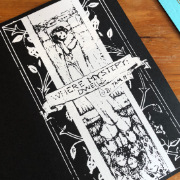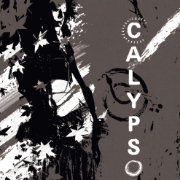Legends and Truth

filed under soloing on 26 Nov 2016
tagged solo and solo frameworks
Inspired by a suggestion on the google+ group for shared solo gaming, I spent the afternoon designing. Yes. The whole afternoon. I made you a pdf of this post.
Edit 12-06: There’s now a systemless version 2.
*Edit 12-7: And a quickstart of version 2.
Solo Intertwined Play
Why? Because it’s exciting to see other people’s takes on your character. Because it’s fun to work in a shared world. Because it’s a rainy day and I’m in currently in love with Stranger Things. Because why not?
Inspiration is tricky; it’s hard to know where ideas come from, especially when you’re running low on sleep and high on coffee. Dabbling in PBEM, IF, MUDs, for sure. Reading about narrative games, likely. Trollbabe and Stranger Things and In a Wicked Age and S\lay w/Me, definitely. If I’ve missed something, let me know.
Legend & Truth
Because we are all playing alone but also together, certain basic tenets must be established. The world is a dark fantasy one, for the most part. It is cold and dangerous and sad, in some places. People weep and struggle and laugh and have sex and eat dinner, as they do. Monsters are a real problem. Magic is a real thing and often a real problem.
Problems come from people, though, doing what people do – if a ghost haunts you it’s because you betrayed them when they were alive, and if a fae steals your first born it’s because you made a foolish bargain.
If these things even exist, that is. It doesn’t matter, really; problems come from people, doing what people do, and monsters are how those problems manifest.
The World you are playing in is Truth, which is defined by you and decided by you, and Legend, which is defined by everyone else who is playing in the World but still decided by you. So, too, is your hero defined by Legend and Truth.
The Play
The Play is your own personal solo adventure featuring a specific hero. It begins when you say the adventure begins and it ends when you say so. It can encompass a single scene, or a dozen sessions, or a campaign, or anything in between.
The only stipulation is that if you wish for your hero’s personal Legend to grow, you must give other authors the chance to learn of his adventures by sharing the details of your Play with them.
What you say and establish and describe is Truth for the World in your Play. You may incorporate as much or as little of other people’s Legends of the World into your Truth of the World as you please, at your whim, just as they may do for your Legends.
What you say and establish and describe for the World in your Play is Legend for the World for everyone else playing in the World, unless they choose to accept it as Truth in their World.
At the beginning of each Play, at least, state something you know to be True about the World clearly, so that others may add it to their Truth or Legend as they will.
The System
Write down a handful of sentences about your hero that paint a picture of him for those who might wish to add to his Legend. The one from S\lay w/Me or perhaps In a Wicked Age would work, or just make up your own.
I am myself. I am…
Read Trollbabe, or the sadly incomplete Stranger Things, and you essentially have the system; create a character who is strong and powerful and competent, who can do strange and wonderful things roughly divided into the categories of Fighting, Magic, and Social. Choose a number between 2 and 9; roll under this number on a d10 to succeed at Fighting, roll over it to succeed at Magic, and take the worst of the two ranges but include the number itself for Social. Call the groups whatever you please as long as they’re roughly analogous.
Use Stranger Things’ wounds and healing, but Trollbabe’s relationships and modifiers. Use whatever magic you like. And use the following reroll categories instead of the ones in Stranger Things’.
An emotion, A found item, Hidden or specialized knowledge, A supernatural effect or ability, A geographical feature, An element like iron, fire, or bone, A carried item, A sudden ally
You can use one category five times or one element from each of five different categories per session (or refresh, if you prefer not to play in sessions), just as in Stranger Things.
You really don’t need to follow the system rules if you don’t want to. Choose different pieces of the two systems, or drop one, or choose an entirely different system. Go crunchy or fluffy or just tell yourself a story with dice. Use an oracle. Switch systems as you please.
The only rule for system is that you must have a mechanic of some sort that adds randomness to the tale – otherwise the modifier you earn for Legend and Truth are meaningless (and we might end up in a big messy debate about what exactly is a game and that would be distracting). The rest of these rules assume you’re using something similar to what’s laid out above.
Scions of Fate
All player characters are Scions of Fate. Whatever else they are, whether they know it or not, they are Scions, the Chosen of the Fates, and they will never know peace or stability.
A Scion has a distinctive mark that marks him as different and that is hard to conceal, thought it varies among Scions what this mark actually is and if other people will recognize it for what it is or something else. A Scion is not invincible, no matter how tough he is. A Scion is not omnipotent or omniscient. A Scion is not granted any special insight simply because he is a Scion.
A Scion can be hurt, or killed, or driven into the sea, or imprisoned beneath the earth, or dismembered, or go mad and murder his whole family in a fit of passion, or any number of terrible things that might seem even more unlikely were he not Fate’s personal plaything.
The only certainty is that wherever a Scion goes, something will change, for better or worse, whether he participates or not.
Those who are embroiled in conflict instinctively recognize the hero as a Scion of Fate, even if they don’t know it consciously, and will seek to turn the Scion to their cause, prevent him from joining their enemies, wield him as a tool against their enemies, or simply remove him from the arena of play. A Scion has no obligation to participate in any conflict and may even seek to avoid them, but the conflict will be changed by the mere fact of his passage or presence.
To complete your Scion, choose a Drive, as specific or broad as you wish; this is what keeps your character moving, through his adventures and through Legend. Hercules had pride; Tristan, love. Achilles, violence. Whatever you choose for your hero, Fate will use to play him like a fiddle, so choose wisely.
violence, sex, love, creation, destruction, justice, gluttony, negation, something else
A Scion always recognizes another, unless he’s not paying attention, distracted, ensorcelled, the other Scion is actively hiding it and he doesn’t notice, or something else happens. Perhaps it’s wiser to say “a Scion almost always has the ability to recognize another”.
Finally, mortals will always, sooner or later, become uncomfortable around the Scion. It is hard for mortal minds to constantly be reminded of larger things, and the Scion’s life is full of chaos and danger. The Scion is free to hope that this time might be different….
Building a Legend
There are two ways to build your hero’s Legend.
The first is to ask someone else for input; this is really exactly as it sounds. Find someone you know (or know of) and ask them a question about your hero.
- What did I do at the battle of Three Falls?
- When I was staring down the gullet of the demon in the ruined temple in the Cold Wastes, what happened?
- Why am I called “The Bitterest Draught” in certain circles, and which circles are those?
- I knew this guy once who knew a secret about the Gods… where did he and I meet?
- Tell me something I don’t know about my hero.
Or really any question you’d like. You don’t have to give them any context at all but you can. They’re under no obligation to answer, and you can choose whether their answer is Legend or Truth or must have been about some other guy.
The second method is to ask an author from another Play to add your character to their Legend, or accept such an offer from another author.
Any author of any Play may ask to have their character join yours. If you accept, that character is considered to have a Relationship to your character, and is under your control just as a standard NPC would be in your Play – in all respects. The converse is also true; if you accept, your character becomes part of their Play, and they have complete control over your character in their Play.
This control is not revokable; if they want to make your character into a fool or a sex slave or a mass murderer, whatever, they may (though one would hope it would at least serve the purposes of the story).
They do, however, have to start with the basics you’ve laid out as to things like name, gender, and Drive, or it’s obviously an imposter and no one will believe it is part of your Legend.
As always, you have ultimate control over what is the Truth in your Play (and only your Play); your timeline is the one that is Truth for you, though all stories of your hero that you know of will add to your Legend unless you explicitly declare them to be about an imposter, in which case all benefits are lost to you.
And that’s why you will expose your character to someone else’s tender mercies – the benefits. Whenever an aspect of your Legend – the fiction built by others around your character – comes into play, you may take a +2 (or -2, whichever is best for you) for all rolls that are affected by it, if it is in fact Truth. If it remains Legend, you may use it as a reroll, in a reroll category called “my legend”, if it would make sense to do so (and following the usual 5 of 1/1 of 5 rule). When using your Legend on a reroll, you add a +1 to that specific reroll.
You are never obligated to use an entire Legend or someone else’s Play as Truth, even if you co-opt part of it. You may also reflavor or put your own spin on it or even adapt it wholecloth. “You see, she thought she saw me kissing that demon, but this is what really happened…”
Example
Meg’s character, the fiesty red-headed witch Isabeth, is embroiled in a court intrigue in a royal court and Meg’s not sure where to go next with it; when Jim asks if his character, Con (a wandering swordsman) can join her Play, she decides to accept the offer.
During her Play, the two have a tumultuous affair, Con loses a hand in a duel for her honor, and ultimately he unleashes a dark demon on the whole court through a combination of drunken magic and carelessness that Isabeth only narrowly manages to contain.
Meanwhile, in Jim’s own Play, Con defeats a wicked and seductive flame sorceress, Isabeth, exiling her to the Cold Wastes for her crimes.
Meg’s Play is Truth for Meg. Isabeth just had a torrid love affair with a wandering swordsman who was maimed over it and defeated a demon in the process.
She is a feisty witch, not a wicked sorceress, and she certainly doesn’t live in the Cold Wastes, unless of course Meg decides to accept any of these items as Truth. If she doesn’t, the tale goes into her Legend.
If Isabeth is ever in a situation where convincing someone she’s a wicked sorceress is necessary, she can use this aspect of her Legend as a reroll with a +1 to it. If she needs to seduce someone, she can pull that out of her Legend, declare it Truth, and give herself a +2 to rolls intended to accomplish her goal of seduction.
Jim’s Play is Truth for Jim. Con has both hands, is a teetotaler, doesn’t like feisty red-headed witches, and has just banished a sorceress to the Cold Wastes. If he’s ever in a situation where he needs to know how to summon a demon, however, he may decide that that part really did happen.
In that case, it is now Truth, and he takes a +2 for the rest of the attempt to summon the demon (and any time he tries to in the future).


